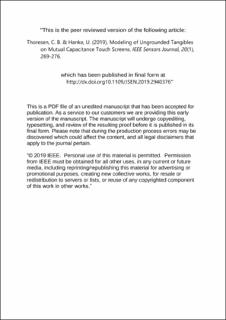| dc.contributor.author | Thoresen, Christian Bjørge | |
| dc.contributor.author | Hanke, Ulrik | |
| dc.date.accessioned | 2020-03-30T11:14:58Z | |
| dc.date.available | 2020-03-30T11:14:58Z | |
| dc.date.created | 2019-12-18T08:59:39Z | |
| dc.date.issued | 2019 | |
| dc.identifier.citation | IEEE Sensors Journal. 2019, 20 (1), 269-276. | en_US |
| dc.identifier.issn | 1530-437X | |
| dc.identifier.uri | https://hdl.handle.net/11250/2649366 | |
| dc.description.abstract | Tangible user interface for touch screens, where interaction happens through tangible objects placed on the screen, is one possible option for addressing the lack of haptic feedback in touch screens. For the development of tangible user interface for mutual capacitance touch screens, it is of interest to be able to model how a tangible on the screen surface is seen by the touch screen controller. Finite Element Method simulations for this case is very demanding in terms of both computational resources and time. In this article, we present a computationally efficient model for simulating the capacitance image of arbitrarily shaped conductive sheets on full size mutual capacitance touch screen panels, with calculation time in the order of milliseconds. Output data from the model show good agreement with corresponding measurement data from experiments, with a root mean square deviation of 1.5% of the peak to peak of the measured values for the modeled screen area. | en_US |
| dc.language.iso | eng | en_US |
| dc.title | Modeling of Ungrounded Tangibles on Mutual Capacitance Touch Screens | en_US |
| dc.type | Peer reviewed | en_US |
| dc.type | Journal article | en_US |
| dc.description.version | acceptedVersion | en_US |
| dc.rights.holder | “© 2019 IEEE. Personal use of this material is permitted. Permission from IEEE must be obtained for all other uses, in any current or future media, including reprinting/republishing this material for advertising or promotional purposes, creating new collective works, for resale or redistribution to servers or lists, or reuse of any copyrighted component of this work in other works." | en_US |
| dc.source.pagenumber | 269-276 | en_US |
| dc.source.volume | 20 | en_US |
| dc.source.journal | IEEE Sensors Journal | en_US |
| dc.source.issue | 1 | en_US |
| dc.identifier.doi | 10.1109/JSEN.2019.2940376 | |
| dc.identifier.cristin | 1762280 | |
| dc.relation.project | Norges forskningsråd: 245963 | en_US |
| dc.relation.project | Norges forskningsråd: 217788 | en_US |
| cristin.ispublished | true | |
| cristin.fulltext | postprint | |
| cristin.qualitycode | 2 | |
